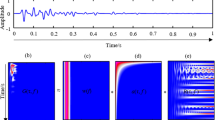Abstract
Deconvolution denoising in the f-x domain has some defects when facing situations like complicated geology structure, coherent noise of steep dip angles, and uneven spatial sampling. To solve these problems, a new filtering method is proposed, which uses the generalized S transform which has good time-frequency concentration criterion to transform seismic data from the time-space to time-frequency-space domain (t-f-x). Then in the t-f-x domain apply Empirical Mode Decomposition (EMD) on each frequency slice and clear the Intrinsic Mode Functions (IMFs) that noise dominates to suppress coherent and random noise. The model study shows that the high frequency component in the first IMF represents mainly noise, so clearing the first IMF can suppress noise. The EMD filtering method in the t-f-x domain after generalized S transform is equivalent to self-adaptive f-k filtering that depends on position, frequency, and truncation characteristics of high wave numbers. This filtering method takes local data time-frequency characteristic into consideration and is easy to perform. Compared with AR predictive filtering, the component that this method filters is highly localized and contains relatively fewer low wave numbers and the filter result does not show over-smoothing effects. Real data processing proves that the EMD filtering method in the t-f-x domain after generalized S transform can effectively suppress random and coherent noise of steep dips.
Similar content being viewed by others
References
Ba, J., Lu, M. H., and Yang, H. Z., 2007, Zero-crossing filter based on wavelet analysis for seismic denoising: Journal of Tsinghua University (Science and Technology), 47(2), 284–287.
Battista, B. M., Knapp, C., McGee, T., and Goebel, V., 2007, Application of the empirical mode decomposition and Hilbert-Huang transform to seismic reflection data: Geophysics, 72(2), H29–H37.
Bekara, M., and van der Baan, M., 2007, Local singular value decomposition for signal enhancement of seismic data: Geophysics, 72(2), V59–V65.
Bekara, M., and van der Baan, M., 2009, Random and coherent noise attenuation by empirical mode decomposition: Geophysics, 74(5), V89–V97.
Canales, L., 1984, Random noise reduction: 54th Ann. Internat. Mtg., Soc. Expl. Geophys., Expanded Abstracts, 525–527.
Flandrin, P., Rilling, G., and Goncalves, P., 2005, Empirical mode decomposition as a filter bank: IEEE Signal Processing Letters, 11, 112–114.
Gabor, D., 1946, Theory of communication: Journal of IEEE, 93(3), 429–457.
Galbraith, M., 1991, Random noise attenuation by f-x prediction: A tutorial: 61th Ann. Internat. Mtg., Soc. Expl. Geophys., Expanded Abstracts, 1428–1431.
Harris, P. E., and White, R. E., 1997, Improving the performance of f-x prediction at low signal-to-noise ratios: Geophysical Prospecting, 45, 269–302.
Hassan, H., 2005, Empirical mode decomposition EMD of potential field data: Airborne gravity data as an example: 75th Ann. Internat. Mtg., Soc. Expl. Geophys., Expanded Abstracts, 704–708.
Huang, N. E., Shen, Z., Long, S. R., Wu, M. L., Shih, H. H., Zheng, Q., Yen, N. C., Tung, C. C., and Liu, H. H., 1998, The empirical mode decomposition and Hilbert spectrum for nonlinear and non-stationary time series analysis: Proceedings of the Royal Society of London Series A-Mathematical Physical and Engineering Sciences, 454, 903–995.
Jones, L., and Parks, T. W., 1990, A high resolution dataadaptive time-frequency representation: IEEE Trans. Signal Process, 38(12), 2127–2135.
Rilling, G., and Flandrin, P., 2009, Sampling effects on the empirical mode decomposition: Advanced Adaptive Data Analysis, 1, 43–59.
Roohollah, A. and Siahkoohi, H. R., 2008, Ground roll attenuation using s and x-f-k transforms: Geophysical Prospecting, 56, 105–114.
Shen, H. Y., Li, H. Y., and Li, Q. C., 2010, SVD (singular value decomposition) seismic wave field noise elimination in frequency domain: Oil Geophysical Prospecting, 45(2), 187–189.
Stockwell, R. G., Mansinha, L., and Lowe, R. P., 1996, Localization of the complex spectrum: The S transform: IEEE Transactions on Signal Processing, 44(4), 998–1001.
Author information
Authors and Affiliations
Additional information
This work was sponsored by the National Natural Science Foundation of China (Grant No. 41174114) and the National Natural Science Foundation of China and China Petroleum & Chemical Corporation Co-funded Project (No. 40839905)
Cai Han-Peng received his MS at Chengdu University of Technology (CDUT) in 2009. Currently, he is a PHD student at CDUT in Earth Exploration and Information Technique. His research work mainly focuses on noise attenuation and integrated reservoir prediction.
Rights and permissions
About this article
Cite this article
Cai, HP., He, ZH. & Huang, DJ. Seismic data denoising based on mixed time-frequency methods. Appl. Geophys. 8, 319–327 (2011). https://doi.org/10.1007/s11770-011-0300-6
Received:
Revised:
Published:
Issue Date:
DOI: https://doi.org/10.1007/s11770-011-0300-6




